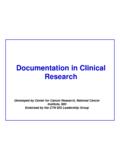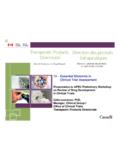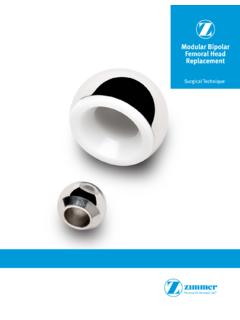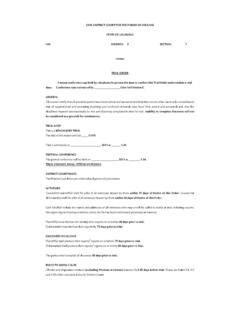Transcription of Monitoring & Auditing of Clinical Trials
1 Monitoring & Auditing of Clinical TrialsDeveloped by Center for Cancer Research, National Cancer Institute, NIHS upported by the CTN SIG Leadership GroupObjectivesGuidelines suggest that following the good Clinical research practice of Monitoring / Auditing should be done for the reasons previously stated. That is why, whether you participate in FDA regulated research or not, there should be some local policies and procedures in place for the routine evaluation ( , an audit) of a Clinical the conclusion of this module you will be able to: Describe the purposes and regulations related to Monitoring of Clinical Trials .
2 Discuss the difference between Monitoring and Auditing . Describe three types of sponsored study visits. Describe the preparation required for and what is reviewed during a Monitoring visit. Describe three types of audits conducted for Clinical trialsOverview Monitoring and Auditing of Clinical Trials is necessary to assure that the: rights and safety of patients ( , human subjects) are protected reported trial data are accurate, complete, and verifiable from source documents conduct of trial is in compliance with protocol, good Clinical practice (GCP) and applicable regulatory requirements.
3 When conducting an IND trial, the regulations require the sponsor to monitor the study. MonitoringAuditingAct of overseeing the progress of a Clinical trialSystematic and independent examination of the trial related activities and documents100% source document verification of all participantsSnapshot in time of a subset of participantsEnsuring that the study is conducted, recorded and reported in accordance with: Protocol, SOPs, GCPs, All applicable regulatory requirementsDetermine whether the trial related activities were conducted and data recorded accurately, analyzed and appropriately reported according to.
4 Protocol Sponsor s SOPs GCP All applicable regulatory requirementsEach protocol will outline a data safety and Monitoring process and planSome studies may require a data safety Monitoring board/committee (DSMB/DSMC)Industry-sponsored TrialsSeveral types of site visits conducted by the sponsor Pre-study qualification visit Initiation visit Monitoring visit Close-out visitPre-study Qualification Visit Purpose: Determine the site's ability to conduct the Clinical trial prior to commencement of the investigation. often place new Trials at sites with a good track record of success Goal of the pre-study qualification visit: Visit the site Meet with study staff Inspect the facilities Sponsor contacts PI Need to determine who the sponsor wants to meet with and what they want to see at the site Allow 2-3 hours for the visit Types of Site VisitsThe next several slides will review the common types of site visits that will be conducted by a Sponsor.
5 Initiation Visit Routine Monitoring Visit Close-out VisitPurposes of Initiation Visit Assure PI and site staff understand: Roles/responsibilities/regulatory obligations Protocol procedures CRF completion instruction review Requirements for records management/retention Drug handling requirements Enrollment and consent procedures Expedited adverse event reporting procedure Patient recruitment resources Identify potential problems and concerns Timing and Scheduling of an Initiation Visit Timing of visit.
6 Prior to patient enrollment After all essential documents in place After supplies received After IRB approval Sponsor/CRO contacts PI/CTN Mutually agreed upon date/time Letter sent to confirm date/time, location, number of attendees Agenda developed and sent by sponsorAttendees Sponsor/CRO: Clinical Research Associate (CRA)/Monitor Medical Monitor Project Manager Site: PI/AIs CTN Data Manager Pharmacist CTN and Data Manager should plan to attend entire meeting. The PI and pharmacist will need to attend, at a minimum, at time designated by the agenda.
7 Others may attend as for an Initiation Review protocol and any other documents received by sponsor/CRO ( : CRFs, Investigator Brochure) Become familiar with the study s procedures Confirm supplies received ( : drug, binders, test tubes, regulatory binder, etc.)..Preparing for an Initiation Visit Write down questions for sponsor/CRO when reviewing documents Secure room Ensure staff availability for the visit Research nurse to remind staff involved a few days in advanceDuring the Initiation Introductions Develop CRO & Site Contact List Review protocol Focus on eligibility criteria, drug.
8 And study procedures Review AE and expedited AE reporting requirements Review regulatory obligations Sponsor and PI the Initiation Visit Review study documentation Drug accountability forms CRFs Logs (enter this visit on the site visit log) Review Regulatory Binder Obtain signatures for Signature Log Obtain signatures for Monitoring Log Start delegation of authority log Review sponsor/CRO Monitoring Plan Pharmacy/site tourAfter an Initiation Visit Site to follow-up with sponsor/CRO on outstanding issues (.)
9 Missing CV, CLIA, missing supplies, etc) Monitor sends final site initiation visit report File in the Regulatory BinderPurposes of the Routine Monitoring Visit Review progress of a Clinical study Ensure protocol adherence Assure accuracy of data Assure safety of subjects Regulatory Compliance (CFR & GCP)Timing and Scheduling of Routine Monitoring Visits Timing/Frequency depends on: Complexity of the protocol Disease being studied Rate of recruitment PI/staff experience Site performance Sponsor s SOPs Frequency not dictated by FDA regulations, but FDA will hold Sponsor accountable for their SOPs.
10 Monitor contacts PI/CTN requesting the first Monitoring visit (email, phone call) Date and time negotiated Monitor confirms via letter to PI Date and time Expectations of visit Which record/patients will be reviewedAttendees Sponsor/CRO Clinical Research Associate (CRA)/Monitor Site PI, AIs CTN, Protocol Coordinator Data Manager Pharmacist CTN and Data Manager should plan to attend entire meeting. The PI and pharmacist will need to meet w/Monitor at pre-assigned next several slides review how to prepare for a successful Monitoring , review your institution s SOP as applicable.













